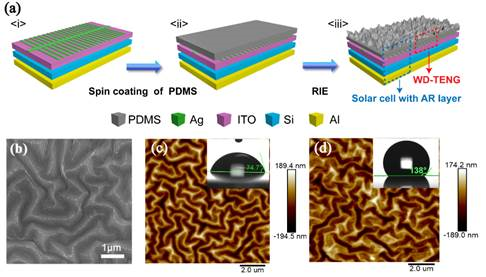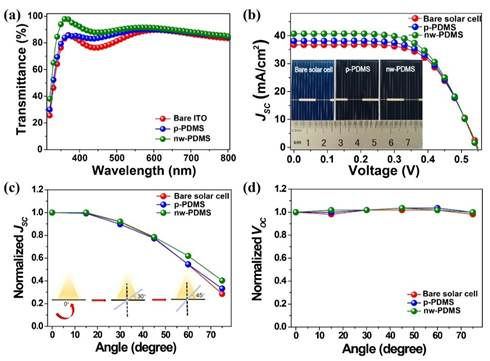Recently, the research result of Professor Cheng Gang’s group "Hybrid Energy Harvester with Bi-Functional Nano-Wrinkled Anti-Reflective PDMS Film for Enhancing Energies Conversion from Sunlight and Raindrops" has been published in Nano Energy (IF=15.548).
Article link: Article link: https://doi.org/10.1016/j.nanoen.2019.104188
Solar cells can directly convert solar radiation energy into electrical energy, and no additional environmental pollution will be caused during the photoelectric conversion process, thus attracting people's attention. However, due to the unbalanced distribution of solar radiation in time and space, the working efficiency of solar cells in the complex and changeable natural environment is reduced. Therefore, combining solar cells with other forms of energy harvesting and developing hybrid energy harvesters has important practical significance for the efficient acquisition and stable output of electrical energy. However, the introduction of traditional water droplet triboelectric nanogenerators affects the light absorption of solar cells, resulting in a decrease in solar cell efficiency.
In this work, Professor Cheng Gang’s research team prepared a PDMS film with a nano-fold structure in a composite energy harvester. This film can not only increase the electrical output of the water droplet triboelectric nanogenerator, but also improve the solar cell’s performance through anti-reflection. Light absorption and cell efficiency. The PDMS film with nano-folded structure can reduce the reflection of incident light, improve the utilization of incident light, and increase the efficiency of Si solar cells from 12.55 to 13.57%. At the same time, due to the high specific surface area and strong hydrophobicity of the PDMS film, the open circuit voltage and short circuit current of the water droplet triboelectric nanogenerator increased by 385.5% and 299.1%, respectively. Utilizing the multiple functions of hydrophobicity and anti-reflection of the PDMS film, the solar and raindrop energy collection efficiency of the composite energy harvester has been enhanced at the same time, which provides ideas and methods for the development of high-performance composite energy harvesters. Moreover, the preparation method of the composite energy harvester is simple and convenient, is also suitable for other types of solar cell systems, and has universal applicability and broad application prospects.

Figure 1. (a) Composite energy harvester structure and preparation flow chart; (b) SEM image of patterned PDMS surface; (c) AFM image of unfluorinated PDMS film; (d) AFM image of PDMS film after fluorination treatment .

Figure 2. (a) Transmission spectra of ITO, planar PDMS/ITO, and PDMS/ITO with corrugated surface structure; (b) Efficiency test graphs of solar cells with different structures (the illustration shows the exposed, planar PDMS covered and corrugated surface structure PDMS covered solar Optical photo of the battery); (c) and (d) are the fitting curves of VS VOC and PCE values at different light incident angles.
Doctoral students Liu Xiaolan, Professor Cheng Ke and Dr. Cui Peng are the co-first authors of the paper, and Professor Cheng Gang and Professor Du Zuliang are the co-corresponding authors of this paper. This work was supported by funding from the National Natural Science Foundation of China, the Science and Technology Department of Henan Province and Henan University.